TTAB Affirms Refusal to Register Toilet Symbol for Nurse-Call Device: Fails to Function as a Trademark
The Board affirmed a refusal to register the design shown immediately below under Sections 1, 2 and 45 of the Trademark Act, on the ground that the proposed Toilet Symbol fails to function as a trademark for "electronic apparatus used in nurse call systems, namely, an electronic device for automatically sending communication transmissions between patients and predetermined and/or specified health care or hospital personnel for use by patients requiring bed pan or other nursing services." The Board agreed with the PTO that the design is merely a pictorial representation of an important feature or function of the goods and would not be recognized by consumers as a mark. In re West-Com Nurse Call Systems, Inc., Serial No. 78438594 (September 13, 2007) [not precedential].

The purported mark appears on a button at the bottom of the device, "pillow speakers," shown below.

Applicant West-Com contended that the design appears as a source indicator in print advertising, on DVDs, and on website pages. The design is there seen by Applicant's customers, who are not patients but rather hospital and nursing home administrators. According to Applicant, the design enables administrators "to pick out and distinguish it from the trademarks of others." West-Com submitted evidence that the design has been used for more than ten years and that the product has generated more than $12 million in revenues. Twenty-eight essentially identical statements from West-Com dealers stated that the design "indicates products produced by" Applicant.
The Board, however, agreed with Examining Attorney Michael Tanner that the design fails to function as a mark, but instead is "an informational icon representing the purpose or function of the button on which it appears." It would not be perceived by consumers as a source indicator.
The Examining Attorney made of record numerous architectural floor plans "in which symbolic designs very similar to applicant's toilet caricature design are used to represent a toilet or commode," to show that the public is accustomed to seeing such designs to designate a toilet.
Although Applicant's design may be unique "in the sense that it is a 'one and only,' the record demonstrates that it is not unique in the sense that is has an 'original, distinctive, and peculiar appearance' which conveys only a trademark significance." The Board was persuaded by the Examining Attorney's argument that:
"Given the industry-wide use of small, highly intuitive decorative icons in this field, consumers would be hard-pressed to realize that the pictorial icon on any particular button of a nurse paging system represents the underlying manufacturer. In this case, the relevant practices of the trade compel a finding that the applicant's 'artistic work' is just that, a decorative picture that consumers and users would immediately recognize as a call button for bathroom assistance, [and] not an indicator of source for the communication device."
The additional evidence submitted by Applicant was not persuasive that the design would nevertheless be recognized as a mark. The fact that West-Com's customers are not patients but administrators is irrelevant; they would view the design no differently. Nothing in Applicant's advertising shows use of the design in the manner of a mark. Finally, the 28 dealer statements were unverified, self-serving, and insufficiently convincing to overcome the PTO's evidence, particularly in light of the lack of materials showing promotion of the design as a mark.
The Board therefore affirmed the refusal to register.
Text Copyright John L. Welch 2007.




1 Comments:
Both the attorney and the board obviously do not know the healthcare marketplace.
Post a Comment
<< Home